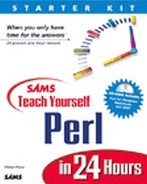Q&A
| Q1: | I'm familiar with another programming language, C, which has a switch (or case) statement. Where is Perl's switch statement? |
| A1: | Perl doesn't have one! Perl provides such a variety of tests that figuring out the best syntax for a switch statement is nightmarish. The simplest way to emulate a switch statement is as follows:
if ($variable_to_test == $value1) { statement1; } elsif ($variable_to_test == $value2) { statement2; } else { default_statement; } The online syntax manual page—which you can view by typing perldoc perlsyn at a command prompt—contains many clever examples of how to emulate a switch statement in Perl, some with very switch-like syntax. |
| Q2: | How many for (while,if) blocks can I nest inside each other? |
| A2: | As many as you like, within memory restrictions of your system. Usually, however, if you have deeply nested loops, it a sign that you should approach the problem differently. |
| Q3: | Help! Perl is giving me the message Unmatched right bracket (or Missing right bracket). The line number reported is the end of the file! |
| A3: | Somewhere in your program, you've used an open brace ({) without a close brace (}), or vice versa. Perl can sometimes guess where the typo is in your program, but sometimes not. Because control structures can nest arbitrarily deeply, Perl doesn't know you've made a mistake until it unexpectedly reaches the End of File without finding the balancing brace. A good program editor (such as vi, Emacs, or UltraEdit) has features to help you find mismatched braces. Use one. |
..................Content has been hidden....................
You can't read the all page of ebook, please click here login for view all page.
